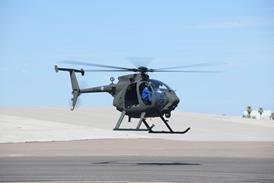Kawasaki Heavy Industries (KHI) has begun marketing avionics and structural enhancements for its locally built version of the Eurocopter BK117, in an effort to boost sales.
In May, the Japan civil-aviation bureau completed type certification of KHI's new active vibration-reduction (AVR) system for the 3.5t-class helicopter. The system is being offered as an option for new-build Kawasaki BK117s, or as a retrofit for existing machines.
KHI's AVR system consists of two Moog hydraulic actuators, installed in place of the BK117's two rear vertical transmission mounts, and a side-mounted spring. The cabin is equipped with three-axis accelerometers, which feed vibration data to a processing unit controlling the excitation of the two actuators.
When activated, the system produces synthesised vibration in the 4/rev (25.6Hz) and 8/rev frequency-range to counter airframe vibration. According to KHI senior manager Masayoshi Onishi, the AVR system has reduced mean vibration levels to close to 0.05g, depending on flight conditions.
The complete AVR system weighs 32kg and costs around ´12 million ($100,000). The first is scheduled to be fitted in July to a machine operated by Japan's Shin Nihon Helicopters.
KHI and local partner Furono are also offering a new combined global-positioning system (GPS) and three-dimensional (3-D) moving-map display, as a visual flight enhancement. The system is designed to reduce the high incidence of controlled flight into terrain in Japan's mountainous environment.
A colour display unit installed in the helicopter's instrument panel is used to indicate surrounding topography and man-made features, relative to the helicopter's position and altitude. Inputted data generates a 3-D moving digital map. It is linked to a GPS receiver, directional gyro and altimeter, to show the helicopter's position, course and ground speed.
Source: Flight International























